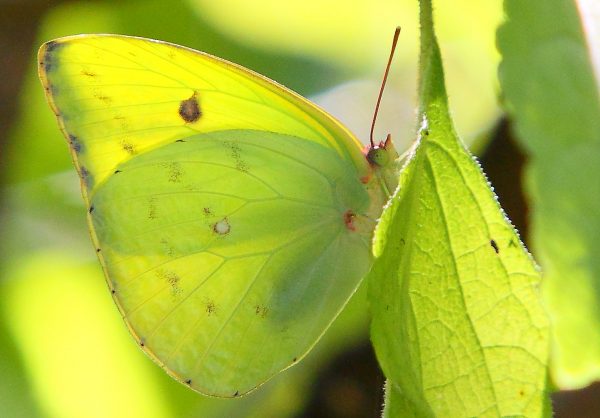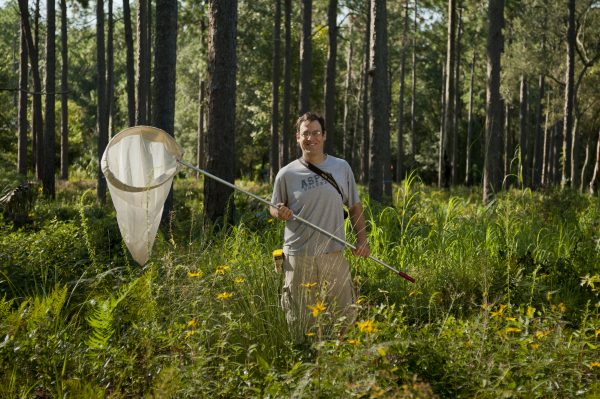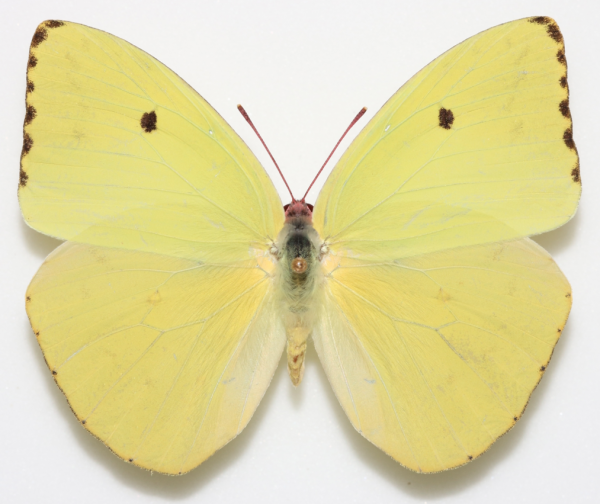
Photo courtesy of Stephen Baig
Thanks to social media and museum collections, a butterfly species was recognized in 2011 after more than 50 years of flying up and down the metro streets of South Florida unnoticed.
With the involvement of the public, scientists at the Florida Museum of Natural History are continuing to learn more about one of Miami’s most common butterflies.
While working in the vast collections of the Museum’s McGuire Center for Lepidoptera and Biodiversity, lepidopterist and senior collections manager Andy Warren noticed a unique butterfly captured in Dade County in 1959, with bright pink spots near the base of its wings.
“It just kind of jumped out at me,” Warren said, noting he didn’t recall seeing the specimen previously.
Warren identified the specimen as Aphrissa neleis, or the Pink-spot Sulphur butterfly—unreported in the United States and thought to only exist on Cuba and two Bahamian islands. The pink spots at the base of the wings, reduced black markings on the edge of the forewing and unique pattern of black spots clearly identified the butterfly. Warren initially thought the find must be a mistake–perhaps a mislabeled specimen–so he immediately began searching further into the collections. The same day he found four more Florida specimens of A. neleis from Miami, collected in 1982 and 1985.
“This butterfly is basically a species that nobody really knew much about,” Warren said. “It was so poorly known to everybody, which is partly why no one recognized it. No one would have guessed it was a dirt common butterfly in Miami.”
Warren collaborated with other scientists to publish an article about his find in the March 2011 issue of News of the Lepidopterists’ Society. In the paper, the authors speculated it was possible A. neleis could still be “somewhere in southern Florida.” Although the collections confirmed the butterfly had once lived among the urban centers of southeast Florida, Warren still needed to determine if it was a current resident.
“We had a paper out, but the people who should’ve been reading it, such as butterfly watchers in South Florida, never saw it,” Warren said. “This is a good example of scientists failing to communicate with the public by disseminating information only in technical publications.”

Florida Museum photo by Kristen Grace
The challenge was determining how to best enlist the help of citizens statewide to find out if the Pink-spot Sulphur still existed in Florida. Warren utilized Listservs to email butterfly enthusiasts around the state and country and collaborated with Alana Edwards, president of the Atala Chapter of the North American Butterfly Association, based in Palm Beach County, to query regional butterfly watchers. Almost immediately, Warren began receiving images of Pink-spot Sulphurs from the last decade, including a 2007 photo from Homestead and a 2011 video of the butterfly from Boca Raton.
“So this nailed it,” Warren said. “We knew it was a current resident of southeast Florida. It has been hiding in plain sight since at least 1959 and nobody knew it was there.”
Before long, word spread about the “new” butterfly species in Florida via blogs and news stories by science journalists, as well as through social media, including Facebook and YouTube.
“Word got out and everybody in South Florida got excited,” Warren said. “More and more photographs of live Pink-spot Sulphurs began coming in from southeast Florida, and the Museum verified several additional specimens in private collections captured between 1985 and 2011.”
The discovery provided scientists with an opportunity to document the species’ life history, as well as learn more about its distribution in Florida and seasonal patterns of abundance, Warren said. Nothing was known about the early stages of A. neleis upon its discovery in Florida, except that Lysiloma sabicu, a non-native tree known as ‘shaggy bark’ that grows in South Florida, was reportedly a caterpillar food plant for the species in the Bahamas. Once again, scientists communicated with butterfly watchers, who observed and documented the species laying eggs on leaves of the tree.
By May 2012, two southeast Florida butterfly enthusiasts, E.J. Haas and Frank Poor, had collected eggs and caterpillars of A. neleis and reared them to adulthood, while documenting the process with photos and voucher specimens deposited at the Museum. At last, the complete life history of the Pink-spot Sulphur was known, Warren said.
“Everywhere they found the tree with new growth, they found the butterfly,” Warren said. “We now know it’s one of the most common urban butterflies in the Miami area. It’s actually one of just two or three uniquely urban butterflies in southeast Florida. Most butterflies are in parks or the everglades, but this non-native butterfly is feeding on a non-native tree that has been planted in urban areas, so it’s just there floating above the hustle and bustle of the city.”

Florida Museum photo by Andrew Warren
After two and half years of researching A. neleis from afar, Warren traveled to Miami in August 2013. It didn’t take him long to locate L. sabicu at Greynolds Park Golf Course, in North Miami Beach, with dozens of Pink-spot Sulphur butterflies flying above it at 40 feet. Warren found an overgrowth of vegetation along a street just outside the golf course, near several shaggy bark trees, and set up camp with his butterfly net and camera.
“From my spot, you could see 80-100 of these butterflies flying around and I caught maybe one out of four that I swung at because they fly super fast,” Warren said. “They also fly high. It was stereotypical butterfly collecting with all the running, jumping and net swinging that you might imagine. It was exhausting, but after two days and several conversations with curious golfers, neighbors and law enforcement personnel, I was able to get fresh specimens for our collections here at the Museum.”
The story of the Pink-spot Sulphur butterfly in Florida demonstrates the potential impact of social media use by scientists and their encouragement of public involvement in scientific discoveries.
Warren hopes to continue involving the public in research on A. neleis to determine if the butterfly also flies in southwest Florida. ‘Shaggy bark’ also grows in the region, but the butterfly hasn’t yet been documented there.
“From the point when I found the first specimens in the Museum’s collection to our current state of knowledge of this species, the research was facilitated by the utilization of means not traditionally used by scientists,” Warren said. “Online media played a huge role in connecting to the public, which was fundamentally important for learning about this newly detected but common butterfly.”
Follow Andrew Warren on Twitter: @AndyBugGuy
Learn more about the McGuire Center for Lepidoptera & Biodiversity at the Florida Museum.